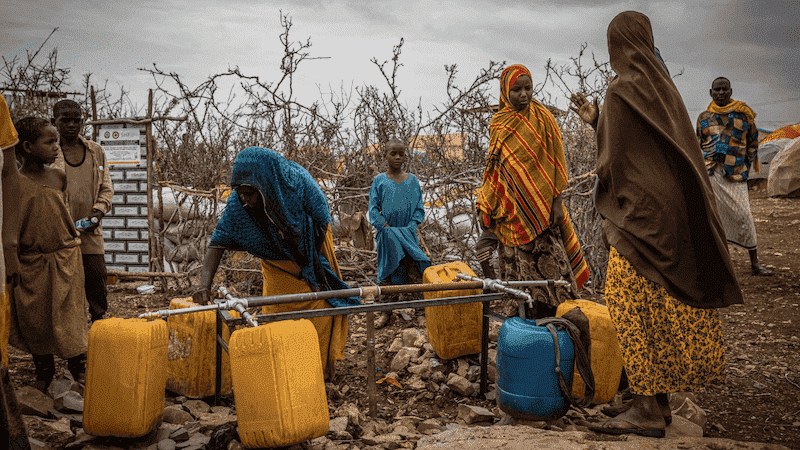Drought and Famine: Ethiopia's Struggle for Survival
Throughout its history, Ethiopia has frequently grappled with severe droughts and famines, with the latest incident happening in 2022. The confluence of global warming, insufficient land availability, water depletion, and food scarcity has ushered in a critical situation, leaving millions of Ethiopians battling for survival.
A Never Ending Cycle that affects Millions of Lives
Throughout its history, Ethiopia has repeatedly endured cycles of droughts and famines. In the 1980’s, years of a deep drought saw the country’s natural water supply drop by 80% resulting in the starvation and death of millions of Ethiopians. The international community responded with massive aid, but to little avail.
Since that time, Ethiopia has taken strides to mitigate famine risks, but the escalating issues related to climate change have exacerbated the situation. The nation has had to grapple with more regular and intense periods of drought, which result in crop devastation, the death of livestock, and scarcity of water. In recent times, the circumstances have grown increasingly critical, leaving millions of Ethiopians grappling with food insecurity.
Water Scarcity and Land Shortages: Fueling Perpetual Drought and Famine
The 2022 drought in Ethiopia was among the most severe in recent history, placing over 10 million people in need of immediate food relief. The crisis was deepened by civil war and population displacement, blocking much needed aid typically provided by international nonprofits.
One of the main issues facing Ethiopia is a shortage of arable land. The country is characterized by mountains and vast stretches of dry plains leaving very little land suitable for agriculture. Due to the stresses of overpopulation, the land that is farmed is overgrazed, over-worked, under fertilized, and depleted over time to the point where it can no longer sufficiently grow food. Another significant challenge is water scarcity, especially prominent in the country's dry plains.
One of the main issues facing Ethiopia is a shortage of arable land. The country is characterized by mountains and vast stretches of dry plains leaving very little land suitable for agriculture. Due to the stresses of overpopulation, the land that is farmed is overgrazed, over-worked, under fertilized, and depleted over time to the point where it can no longer sufficiently grow food. Another significant challenge is water scarcity, especially prominent in the country's dry plains.
Without Help, the Future Looks Bleak
Without immediate interventions, Ethiopia's predicament is anticipated to worsen. Droughts caused by climate change will continue affect Ethiopian farmers capability to grow food as the population continues to grow, exert even more stress on the nation's resources.
While the government has initiated steps to tackle these challenges, the problem far exceeds its capability to address these overwhelming issues. It’s clear that a massive influx of international aid is needed. Investment in agriculture is also required that use water efficient techniques to grow more with less.
Growing To Give: Hope for a Better Future
Drought in Ethiopia is threatening the lives of millions of people. The escalating impact of climate change, yielding irregular and volatile weather conditions, has led to diminished rainfall and extended drought durations. Insufficient agricultural land, alongside overgrazing and deforestation, has instigated soil erosion, further complicating crop cultivation and livestock maintenance. A perpetual state of a water scarcity has created a situation where half of Ethiopia has little or no access to potable water.
Food scarcities, largely due to crop failures and livestock mortality, have thrust numerous Ethiopians into a dire predicament, their existence hanging by a thread. Absent external support, Ethiopia's outlook seems bleak.
The magnitude of the crisis is such that it overshadows the nation's capacity to manage it solely. Nonetheless, a ray of hope presents itself in the form of international aid entities such as Growing To Give.
Growing To Give is committed to alleviating the impacts of the drought and famine crisis in Ethiopia. By providing food and potable water, they are addressing the needs of school children in Addis Ababa, Ethiopia’s capital. Their efforts extend beyond short-term relief, as they also strive to promote sustainable agricultural practices and water conservation, empowering communities to better withstand future crises.
Through their work, Growing To Give brings hope to those who need it most. While the path ahead remains fraught with challenges, the initiatives of such organizations provide a lifeline, offering the promise of a better, more sustainable future for Ethiopia. In a time of crisis, Growing To Give stands as a beacon of hope, proving that through unity, perseverance, and compassion, it is possible to turn the tide.



.png)
.png)
.png)

.png)